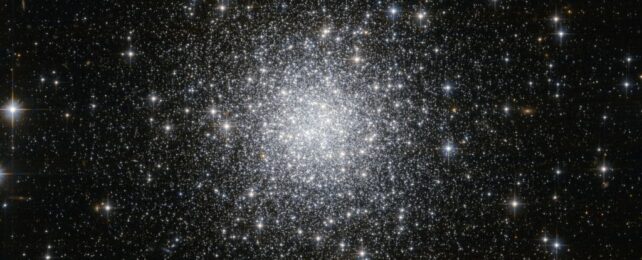We don't know what the first stars in the Universe were like. Peering into the distant reaches of the early Universe, we've seen only traces of their presence.
But a new line of evidence traced in images from the James Webb Space Telescope seems to agree with a recent idea that is gaining traction: that not long after the appearance of the first stars – if not among them – were fusion-powered balls of heat and fury that were absolute colossi, with masses up to 10,000 Suns.
"Today, thanks to the data collected by the James-Webb Space Telescope, we believe we have found a first clue of the presence of these extraordinary stars," says astrophysicist Corinne Charbonnel of the University of Geneva in Switzerland.
The first piece of this puzzle is a type of star group called a globular cluster. These are relatively abundant in the local Universe; there are around 157 objects categorized as globular clusters in the Milky Way. They are very dense, spherical clusters that contain between around 100,000 and 1 million stars; and all those stars have very similar chemical properties, suggesting that they were born around the same time, from the same cloud of gas.
They also often consist of very old stars at death's door; astronomers consider these ancient globular clusters "fossils" of the early Universe, and study them to learn about the chemistry of eons past.
But there's something really peculiar about these older globular clusters. They exhibit chemical abundance ratios that vary from star to star and are difficult to explain: an enrichment of helium, nitrogen, and sodium, and a relative depletion of carbon and oxygen.
The explanation that best fits these abundances is hydrogen burning at extremely high temperatures. In 2013, researchers suggested that one possible way of attaining those high temperatures is in the cores of massive stars. Very massive stars. Supermassive, even, at around 10,000 solar masses, with cores much hotter and at much higher pressures than those of the stars we see around us today.
Charbonnel and her colleague Mark Gieles, previously at the University of Surrey but now at the University of Barcelona, in Spain, then determined in 2018 that it was possible the stellar wind emitted by these stars "polluted" the interstellar medium of globular clusters with these elements. Meanwhile, ongoing collisions with smaller stars replenished the star's mass. Any stars born of the polluted interstellar material would inherit the chemical abundances seeded by the supermassive stars in the early Universe.
Unfortunately those old polluting stars are long dead, their light from nearby clusters has long faded from view.
"Globular clusters are between 10 and 13 billion years old, whereas the maximum lifespan of superstars is two million years," Gieles says. "They therefore disappeared very early from the clusters that are currently observable. Only indirect traces remain."
It's all very neat and tidy; but more observational evidence was required. And then the JWST took a look at a galaxy very, very far away: GN-z11, lurking at just 440 million years after the Big Bang, whose light is only just now reaching us after a 13.3 billion year journey through expanding space.
We've known about GN-z11 for a few years, but it took JWST – the most powerful space telescope ever built – to analyze the spectrum of light it has sent to us across space and time.
The data that came in proved to be rather odd. The interstellar medium of GN-z11 is substantially enriched in nitrogen compared to oxygen, with an abundance ratio that's more than four times that of the Sun… curious, if consistent with the formation of globular clusters astronomers have noted.
Charbonnel and her colleagues conducted a thorough analysis and modeling, and found that giant stars between around 1,000 and 10,000 solar masses that formed through runaway collisions of smaller objects can consistently explain the abundance ratios, not just in globular clusters, but in GN-z11 as well.
"The strong presence of nitrogen can only be explained by the combustion of hydrogen at extremely high temperatures, which only the core of supermassive stars can reach, as shown by the models of Laura Ramirez-Galeano, a Master's student in our team," Charbonnel explains.
The evidence is far from conclusive, but it does tell us where to look for more information. The researchers hope to obtain more data on early galaxies from JWST, looking for similar clues that could help us identify these early chonker stars. In turn, this could help resolve other mysteries, like how supermassive black holes formed in the early Universe, and what the first stars in the Universe were like.
"If the supermassive star scenario can be firmed up by future studies, this would provide an important step for our understanding of globular clusters and for the formation of supermassive stars in general, with numerous important implications," the researchers write.
"In any case, the peculiar properties of GN-z11 just revealed by JWST call for further studies to understand the physical processes ongoing in such extreme objects in the early Universe, and their possible connection with the formation of globulars, supermassive stars, potentially also supermassive black holes among others."
The research has been published in Astronomy & Astrophysics.
